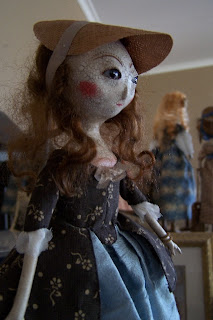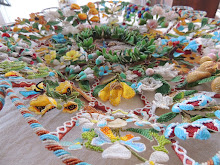 These snapshots leave alot to be desired, but thought you would enjoy them just the same. Alas, I thought I had found the perfect 'girl', but, as you can see.....she is much to well 'endowed' for my stays to fit properly.............my quest will continue! Being a private entity, I just cant afford the 2-3 grand for a correct 18th century form mannequin of proper posture~ I'd rather have another dress. I think you can get a goode idea of what these stays looked like when originally worn.
These snapshots leave alot to be desired, but thought you would enjoy them just the same. Alas, I thought I had found the perfect 'girl', but, as you can see.....she is much to well 'endowed' for my stays to fit properly.............my quest will continue! Being a private entity, I just cant afford the 2-3 grand for a correct 18th century form mannequin of proper posture~ I'd rather have another dress. I think you can get a goode idea of what these stays looked like when originally worn. They are in immaculate, near mint condition~ fully lined in a crisp, original cream linen. Entirely hand stitched over whalebone strips~ too numerous to count. They are so very rigid~ a sheer monstrosity when it comes to trying to store them..........yet, when fitted and laced, they twist and turn in all the right directions, and mold the body like butter. Because of the sheer brute strength needed in the hands to stitch them, nearly all staymakers were men.
They are in immaculate, near mint condition~ fully lined in a crisp, original cream linen. Entirely hand stitched over whalebone strips~ too numerous to count. They are so very rigid~ a sheer monstrosity when it comes to trying to store them..........yet, when fitted and laced, they twist and turn in all the right directions, and mold the body like butter. Because of the sheer brute strength needed in the hands to stitch them, nearly all staymakers were men. All the back lacing eyelets are precisely stitched in white linen, as are the lacing eyelets for the shoulder straps. The main reason these stays don't fit well on a modern form, is the placement of the shoulders~ 18th century posture dictated the arms and shoulders held way back~ all the time~ it was common the shoulder blades to touch each other. While you are sitting comfortably at your computer, take note of your posture, and now, sit erect and jet your shoulders back as far as they will go..........until it is uncomfortable~ chances are, your posture still would not be correct~ hence the need for stays~ they sucked the waist IN, narrowed the ribs down to a conical shape, and thrust the bust UP, pushing the shoulders back until they could go no further.
All the back lacing eyelets are precisely stitched in white linen, as are the lacing eyelets for the shoulder straps. The main reason these stays don't fit well on a modern form, is the placement of the shoulders~ 18th century posture dictated the arms and shoulders held way back~ all the time~ it was common the shoulder blades to touch each other. While you are sitting comfortably at your computer, take note of your posture, and now, sit erect and jet your shoulders back as far as they will go..........until it is uncomfortable~ chances are, your posture still would not be correct~ hence the need for stays~ they sucked the waist IN, narrowed the ribs down to a conical shape, and thrust the bust UP, pushing the shoulders back until they could go no further. I love how contrasting thread was used, and major seams taped in same~ a true work of art.
I love how contrasting thread was used, and major seams taped in same~ a true work of art. It was more common for the back lacing to start at the bottom, and continue up skipping every other eyelet~ then once at the top turn around and lace back down to the bottom......but these have clear wear marks of where the laced originally laid, and I have laced them in that fashion
It was more common for the back lacing to start at the bottom, and continue up skipping every other eyelet~ then once at the top turn around and lace back down to the bottom......but these have clear wear marks of where the laced originally laid, and I have laced them in that fashion The tabs at the bottom not only eased out prettily over the hips, they also gave 'displaced flesh' a place to retreat to
The tabs at the bottom not only eased out prettily over the hips, they also gave 'displaced flesh' a place to retreat toStays shown over a later 1790 linen shift















































